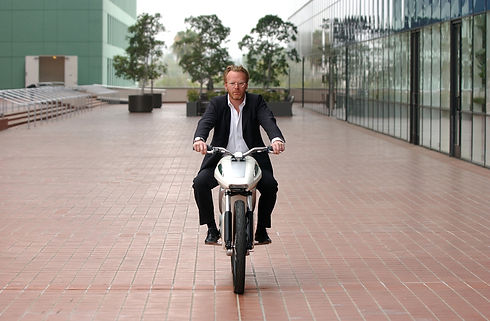


H Y D R O G E N
E C O N O M Y
WORLD’S FIRST HYDROGEN-ELECTRIC MOTORBIKE
CONCEPT, DESIGN, ENGINEERING,
BUILD AND LAUNCH LED BY IMAGINATIVES TEAM

Los Angeles
“Cool bike!”
Steve Jobs
“One of the most amazing inventions”
TIME Magazine
“Eye candy can be earth-friendly”
The Times
“Hydrogen bike that's on the side of the angels”
The Times
“A visionary vehicle”
Design Directory
“The only way to get more environmentally-friendly than this is to walk”
Daily Mirror
“The bike Jesus would ride”
T3
“It might just change the world”
WE People, Taiwan
“The ENV is the world's first motorcycle built around a hydrogen fuel cell. Running clean and quiet, it is, to date, the simplest and most innovative articulation of that technology's potential.”
Business Week
Pioneering Hydrogen
We were already at the frontiers of the hydrogen economy twenty years ago. We created one of the world's premier groups in hydrogen fuel cells in UK and in blue hydrogen technology in USA.
The technology still ranks among best-in-class.
Our team also premiered the use of this technology in the design, build and launch of a prototype motorbike which was one the first electric vehicles. This won world-wide acclaim, media attention and awards.
But this was always more than a technology development; it was a lifestyle change. Silent, zero pollution travel, on road and off, with a detachable motorbike engine as a portable power source for other uses.
We no longer own the company. But we own the ideas!
More than the motorbike, we also built a prototype hydrogen-electric aeroplane with partner Boeing, the world's first. It was flown by a NASA test pilot in 2008.
All of these activities pre-dated the present era of enthusiasm to build the Hydrogen Economy.
They say patience is a virtue!


Patagonia
Latin American Hydrogen
Knowing that countries such as Japan, South Korea and Germany are keen to increase imports of blue and green hydrogen, regions such as South America are gearing up to be suppliers of the future.
With a wealth of opportunity to grow renewable industries, particularly wind, solar and geothermal energy, unsurprisingly attention is being paid to the opportunity to link all such developments to the building of a regional Hydrogen Economy. This has the potential for decarbonisation, evolution of transport, redesign of urban energy and transformation of industry. Should this emerge in the coming years, the potential exists for the vast space and resources of areas such as Patagonia to play its part in regional and global energy supplies, including hydrogen delivery.
We have been asked to contribute ideas and strategies to achieve these goals, based on our understanding of developments globally.



 |  |  |  |  |  |  |
|---|---|---|---|---|---|---|
 |
European Hydrogen
Hydrogen is happening, especially in Europe, with many plans for participation in an estimated €40 billion infrastructure backbone.
The European Union is planning a 15-gigawatt renewable energy tender and auctions for green hydrogen projects as part of a trillion-dollar Green Deal package.
Analysis for ten European countries (Germany, France, Italy, Spain, the Netherlands, Belgium, Czech Republic, Denmark, Sweden and Switzerland), envisages a network gradually emerging from the mid-2020s onwards.
This leads to an initial 6,800 km pipeline network by 2030, connecting hydrogen valleys. The planning for this first phase should start in the early 2020s. In a second and third phase, the infrastructure further expands by 2035 and stretches into all directions by 2040 with a length almost 23,000 km.
It's happening!
